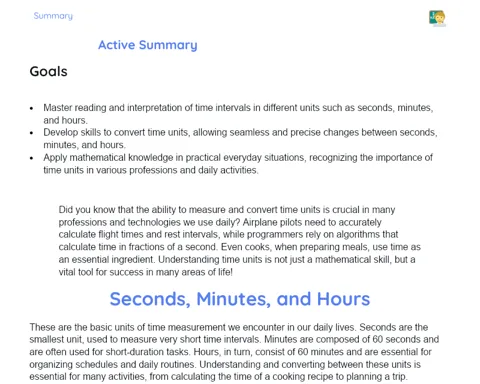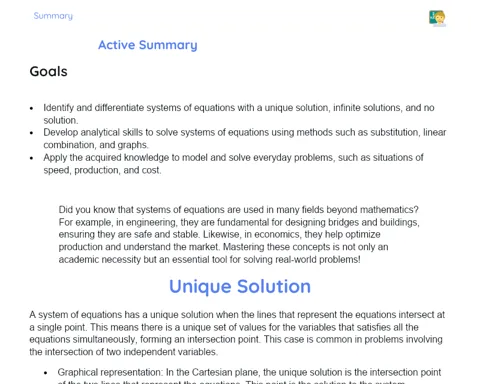Mastering Volumetric Relationships: From Theory to Practice
Objectives
1. Understand the relationship between volume units: liter, cubic decimeter, and cubic meter.
2. Convert volume units between liters, cubic decimeters, and cubic meters.
3. Solve practical problems involving the conversion of volume units.
Contextualization
Volumetric relationships are essential in various everyday situations and many professions. Imagine a civil engineer planning the construction of a water reservoir or a chemist measuring the exact amount of reagents in an experiment. Understanding the different units of volume and the ability to convert them correctly are fundamental to ensuring accuracy and efficiency in such tasks.
Relevance of the Theme
In the job market, especially in fields like engineering, architecture, and applied sciences, precision in measuring and converting volumes is crucial. For example, in civil construction, the amount of concrete needed for a project must be calculated accurately to avoid waste or shortages. Additionally, the ability to convert volume units is an essential skill in various professional and academic contexts.
Relation between Liter and Cubic Decimeter
One liter (L) is equivalent to one cubic decimeter (dm³). This means that any volume measured in liters can be directly converted to cubic decimeters and vice versa, without changing the numerical value. This relationship is fundamental for many practical applications, such as measuring liquids in standard containers.
-
1 liter (L) = 1 cubic decimeter (dm³)
-
This relationship is based on the definition of the liter.
-
Facilitates direct conversion between these two volume units.
Relation between Liter and Cubic Meter
One cubic meter (m³) is equivalent to 1000 liters (L). This means that large volumes typically measured in cubic meters can be converted to liters by multiplying by 1000. This relationship is crucial in contexts involving large volumes, such as in civil construction and industry.
-
1 cubic meter (m³) = 1000 liters (L)
-
1 cubic meter (m³) = 1000 cubic decimeters (dm³)
-
Important for measuring large volumes.
Conversion of Volume Units
The conversion of volume units is the process of transforming a volume measure from one unit to another. To do this, it is necessary to understand the relationship between the different units, such as liters, cubic decimeters, and cubic meters. Precision in conversion is essential to ensure exact measurements in practical contexts.
-
Direct conversion between liters and cubic decimeters.
-
Multiply or divide by 1000 to convert between liters and cubic meters.
-
Precision in conversion is crucial for practical applications.
Practical Applications
- In civil construction, calculate the volume of concrete needed for a project using the relationship between cubic meters and liters.
- In chemical laboratories, measure liquid reagents in liters and cubic decimeters to ensure precision in experiments.
- In designing water storage systems, such as reservoirs, use conversion between liters and cubic meters to size the system correctly.
Key Terms
-
Liter (L): Common volume unit for measuring liquids.
-
Cubic Decimeter (dm³): Volume unit equal to 1 liter.
-
Cubic Meter (m³): Volume unit equal to 1000 liters or 1000 cubic decimeters.
-
Conversion: Process of transforming a volume measure from one unit to another.
Questions
-
How can precision in the conversion of volume units negatively impact an engineering project?
-
In what ways is the ability to convert volume units used in different professions?
-
What would be the consequences of an incorrect volume measurement in a scientific experiment?
Conclusion
To Reflect
Volumetric relationships are fundamental not only for theoretical understanding but also for various practical applications in the job market. Precision in the conversion of volume units can determine the success or failure of a project, whether it be in engineering, architecture, or applied sciences. Through the activities carried out, we could see how crucial it is to understand and correctly apply these conversions to ensure the efficiency and accuracy needed in real situations. Keep practicing these skills, as they are essential for professional and academic development.
Mini Challenge - Practical Challenge: Calculating the Volume of a Tank
To consolidate understanding of volume unit conversion, you will calculate the volume of a water tank with specific dimensions.
- Imagine you have a water tank with the following dimensions: 2 meters long, 1 meter wide, and 1.5 meters high.
- Calculate the total volume of the tank in cubic meters.
- Convert the volume of the tank from cubic meters to liters.
- Convert the volume of the tank from cubic meters to cubic decimeters.
- Check if the conversions are correct and compare the obtained values.



